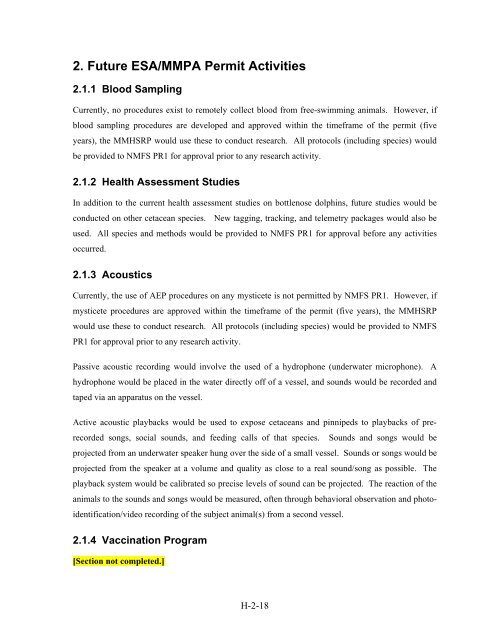Volume III, Appendices EM - National Marine Fisheries Service ...
Volume III, Appendices EM - National Marine Fisheries Service ...
Volume III, Appendices EM - National Marine Fisheries Service ...
Create successful ePaper yourself
Turn your PDF publications into a flip-book with our unique Google optimized e-Paper software.
2. Future ESA/MMPA Permit Activities<br />
2.1.1 Blood Sampling<br />
Currently, no procedures exist to remotely collect blood from free-swimming animals. However, if<br />
blood sampling procedures are developed and approved within the timeframe of the permit (five<br />
years), the MMHSRP would use these to conduct research. All protocols (including species) would<br />
be provided to NMFS PR1 for approval prior to any research activity.<br />
2.1.2 Health Assessment Studies<br />
In addition to the current health assessment studies on bottlenose dolphins, future studies would be<br />
conducted on other cetacean species. New tagging, tracking, and telemetry packages would also be<br />
used. All species and methods would be provided to NMFS PR1 for approval before any activities<br />
occurred.<br />
2.1.3 Acoustics<br />
Currently, the use of AEP procedures on any mysticete is not permitted by NMFS PR1. However, if<br />
mysticete procedures are approved within the timeframe of the permit (five years), the MMHSRP<br />
would use these to conduct research. All protocols (including species) would be provided to NMFS<br />
PR1 for approval prior to any research activity.<br />
Passive acoustic recording would involve the used of a hydrophone (underwater microphone). A<br />
hydrophone would be placed in the water directly off of a vessel, and sounds would be recorded and<br />
taped via an apparatus on the vessel.<br />
Active acoustic playbacks would be used to expose cetaceans and pinnipeds to playbacks of prerecorded<br />
songs, social sounds, and feeding calls of that species. Sounds and songs would be<br />
projected from an underwater speaker hung over the side of a small vessel. Sounds or songs would be<br />
projected from the speaker at a volume and quality as close to a real sound/song as possible. The<br />
playback system would be calibrated so precise levels of sound can be projected. The reaction of the<br />
animals to the sounds and songs would be measured, often through behavioral observation and photoidentification/video<br />
recording of the subject animal(s) from a second vessel.<br />
2.1.4 Vaccination Program<br />
[Section not completed.]<br />
H-2-18
















